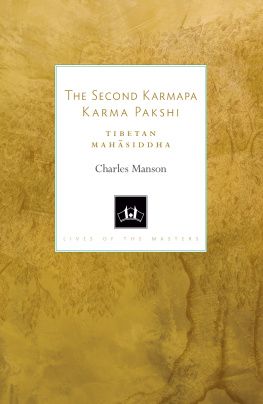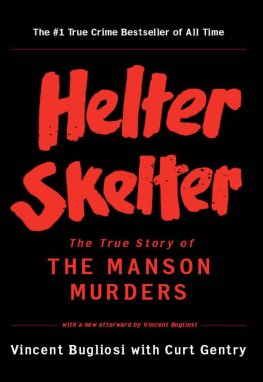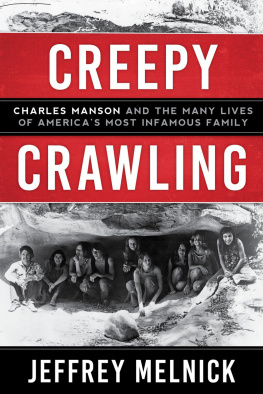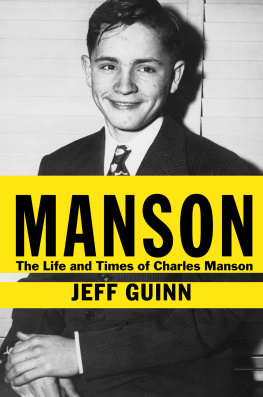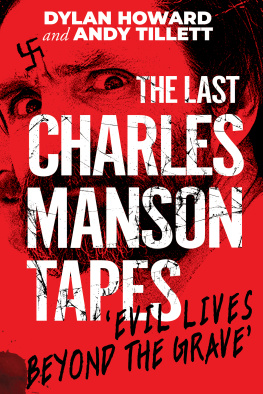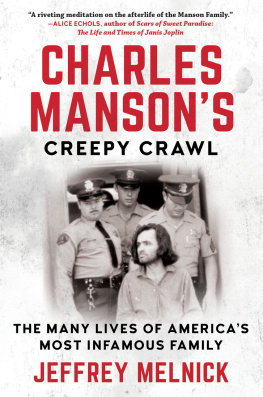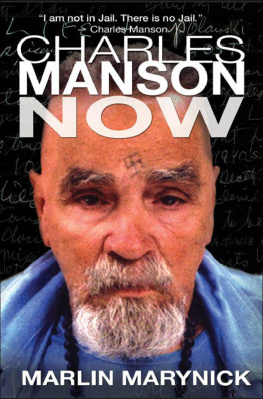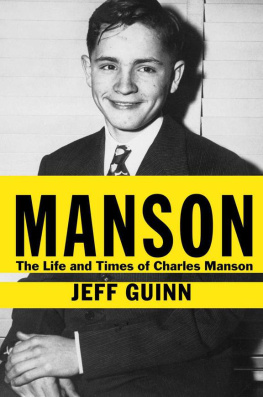Copyright 1986 by Nuel Emmons
All rights reserved. No part of this book may be reproduced in any form or by any electronic or mechanical means, or the facilitation thereof, including information storage and retrieval systems, without permission in writing from the publisher, except by a reviewer, who may quote brief passages in a review. Any members of educational institutions wishing to photocopy part or all of the work for classroom use, or publishers who would like to obtain permission to include the work in an anthology, should send their inquiries to Grove/Atlantic, Inc., 841 Broadway, New York, NY 10003.
Published simultaneously in Canada
Printed in the United States of America
Library of Congress Cataloging-in-Publication Data
Manson, Charles, 1934
Manson in his own words.
1. Manson, Charles, 1934 2. Crime and criminals
CaliforniaBiography. I. Emmons, Nuel. II. Title.
HV6248.M2797A3 1986
364.1'523'0924[B] 86-45257
ISBN-10: 0-8021-3024-0
eBook ISBN-13: 978-0-8021-9638-5
Designed by Abe Lerner
Grove Press
an imprint of Grove/Atlantic, Inc.
841 Broadway
New York, NY 10003
Distributed by Publishers Group West
www.groveatlantic.com
Introduction by Nuel Emmons
In late July and early August of 1969, eight of the most bizarre murders in the annals of crime surfaced. The murders were committed with the savagery of wild animals, but animals do not kill with knives and guns, nor do they scrawl out messages with their victims blood.
On July 31, 1969, homicide officers from the Los Angeles Sheriffs Office were summoned to 946 Old Topanga Canyon Road. When they entered the premises, the officers were assailed by swarming flies and the pungent stench of decaying human flesh. They found one male body, marked by multiple stab wounds, that they established had been dead for several days. On the living room wall a short distance from the body the words POLITICAL PIGGY were scrawled in the victims blood. Also on the wall were blood smudges as though a panther had left its paw print.
The victim was Gary Hinman. Thirty-two years old, Hinman had been attending UCLA in pursuit of a Ph.D. in sociology, supporting himself by teaching music. It was later discovered that for additional income he manufactured and sold a form of mescaline.
On Saturday, August 9th at 10050 Cielo Drive in the plush residential area of Bel Air, adjacent to Beverly Hills and Hollywood, officers from the Los Angeles Police Department arrived at a second crime scene so gory it might well have come from a Hollywood horror film. There, sprawled throughout the house and grounds, were five viciously slain victims, all of whom had been in the prime of their lives. They were Sharon Tate Polanski, Abigail Folger, Voytek Frykowski, Jay Sebring and Steven Parent. And as in the Hinman house there was a bloody message. On the door of the home where the five had lost their lives, in what was later established as Miss Tates blood, was the word PIG.
The shocking massacre brought droves of reporters and photographers who surrounded the restricted area of home and grounds where police investigators sought clues. Nothing but the deaths was certain, yet when the reporters filed their stories, speculation filled the newspapers. Some described the deaths as ritual slayings, others stated the killings were the result of a wild sex party, still others declared the five had died in retaliation for a drug burn. Jealousy and love triangles were also mentioned as motives. Some reporters simply stated what was known at the time; that the police were baffled about the motives for the crime and were still searching for clues in the most bizarre multiple murders ever committed in the Los Angeles area. But this was just the beginning.
On Sunday, August 10th, hardly more than twenty-four hours after the initial call summoning police to the Cielo address, the LAPD was summoned to yet another ghastly death scene: 3301 Waverly Drive in the Los Feliz district of Los Angeles, the home of Leno and Rosemary LaBianca.
Leno, forty-four, was dead as the result of twenty-six stab wounds, some of which were administered with a carving fork. When his body was discovered, the fork still protruded from his stomach, as did a knife from his throat. His thirty-eight-year-old wife Rosemary had been stabbed forty-one times. Again the slain victims home held messages boldly printed in the victims blood: DEATH TO PIGS and RISE on a wall, and the misspelled words HEALTER SKELTER on the refrigerator door. District Attorney Vincent Bugliosi would ultimately theorize that Helter Skelter explained the motive for the slayings, but for the present, everything but the nights of horror and the eight brutally assaulted bodies was a baffling mystery.
As news of the murders swept the country, newspapers, radio and television were quick to report anything associated with what soon became known to the world as The Tate-LaBianca Slayings. The crimes and the news coverage had a chilling effect in and around the Hollywood area. Fear and suspicion gripped the homes, hearts and streets throughout southern California. Guns and weapons were purchased for self-defense in record numbers. Police investigators, pushed to find a suspect, worked long hard hours checking clues and following leads. Although several days after Hinmans death a suspect named Robert Beausoleil had been arrested, no one linked him to the slayings in the heart of Hollywood. It was not until months later, when a second suspect in the Hinman case was arrested, that some light would be shed on the Tate-LaBianca slayings.
That second suspect was Susan Denise Atkins, who would eventually be convicted for the previously mentioned deaths, as well as the death of one Donald Jerome (Shorty) Shea, a ninth victim whose murder did not surface until the killers were apprehended. (His body, a mystery during the trial, was not discovered until several years later.) Atkins flamboyantly confided her participation in the deaths to jail-house acquaintances, and described Charles Manson as a charismatic cult leader, a living Jesus, a guru possessing mystical powers strong enough to entice his followers to kill for him. Atkins jail confidants relayed the disclosure to the police, who announced in a press conference at the beginning of December that the grisly murders of five months past were at last solved.
With Manson and several other suspects in custody, Atkins sold a copyrighted story, Two Nights of Murder, to The Los Angeles Times and several foreign newspapers, and before Christmas, 1969, the world read the sensational story. It, and similar stories that followed, made Manson the most publicized and discussed villain of our time, even before he went to trial. During the trial, under the persistent attention of the media, Charles Milles Manson and his followers (now described as the Manson Family), would gain worldwide notoriety.
Manson was charged with being the mastermind that unleashed the animal savagery in his followers. As motive for the slaughters, prosecuting attorney Bugliosi established that Manson believed, and convinced his followers, that there would eventually be an uprising by blacks against whites which Manson referred to as Helter Skelter, from the Beatles song of the same name. Manson was said to have ordered his followers to commit bizarre murders to accelerate this conflict, leaving false evidence to indicate that the violent acts had been committed by blacks. There was also the suggestion that Manson had chosen the Cielo Drive residence because it had formerly been occupied by Terry Melcher, a recording company executive who had failed to promote Mansons recording efforts. When Manson initiated the killings he remembered Melchers rejection and the secluded location of his former home, making it an ideal place for murder.


